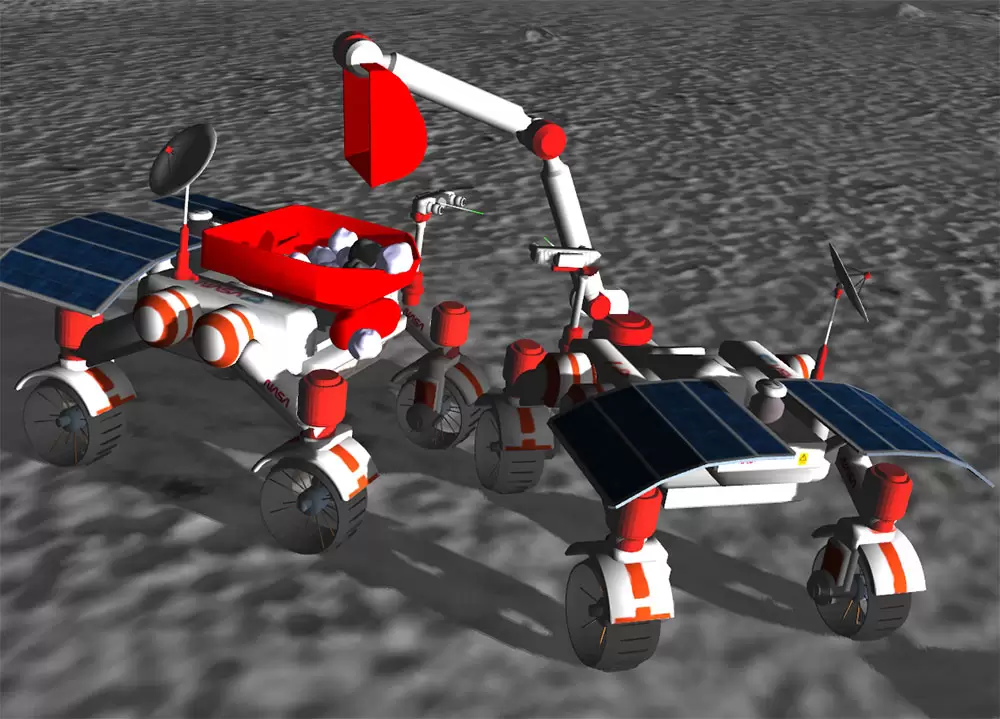A team of students from the University of Adelaide has taken out third prize and US$75,000 in the NASA Space Robotics Challenge, as well as an Innovation Award for its work on critical challenges in the competition.
The Space Robotics Challenge is a virtual competition that aims to advance robotic software and autonomous capabilities for space exploration missions on the surface of extraterrestrial objects, such as distant planets or moons.
Entrants were asked to consider how future astronauts will survive on distant planets, allowing missions to focus on more important projects as we explore the cosmos. The challenge was undertaken in a NASA simulation of the lunar south polar region.
Professor John Culton, University of Adelaide’s Director of the Andy Thomas Centre for Space Resources, said they were up against teams from the world’s top universities, as well as corporate and private groups.
“The participants were challenged to design code to control a fleet of different lunar robots that had to locate, excavate, load and transport water ice, and other volatile substances, to a lunar landing craft,” he said.

The only Australian entrant in the competition, a 40-person team of both students and staff from the University of Adelaide competed alongside 113 other teams from around the world, with only 22 groups selected to vie for first prize. The team was also awarded one of only two NASA Innovation Awards.
“The NASA engineers recognised the team’s particularly novel solution to critical challenges currently confronting NASA as they prepare for lunar surface operations in the next several years,” Professor Culton said.
“The code they developed could be used in NASA’s Artemis human spaceflight program, which aims to send people to the Moon by 2024, to make its surface rover fleet more autonomous.”
How they did it
Team lead Ravi Hammond told create that the logistics of entering the competition were a challenge in themselves.
“The first major problem we faced was to figure out a way for more than 40 developers to seamlessly work on the same system simultaneously,” he said.
“We solved this by having the three team leads — Ragav Sachdeva, James Bockman and myself — create an underlying framework to allow coders to seamlessly plug and play their code.
“Ragav wrote a program to allow different state-machine configurations, James created a software interface between our code and the robot’s onboard equipment, and I created a behaviour framework to allow the rovers to perform tasks.”
The framework enabled the team to simultaneously develop without conflict, and begin to work on other problems that the challenge presented.
“We also needed the rovers to traverse the map without driving into obstacles and craters. To achieve this we used an object detection algorithm to locate the obstacles using onboard cameras, and used stereo-depth to calculate their precise location in the world,” Hammond said.
“All obstacles within a rover’s field of view are added to a live map, and we use a hand-written pathfinding algorithm to find a safe route through the map. As a robot moves, it sees more obstacles, and the pathfinding algorithm will adjust the route accordingly.”
Valuable lessons
Hammond said one of the valuable lessons he learned from participating in the challenge was overcoming what he calls “unknown unknowns”.
“When discussing possible solutions, there were issues that we were aware of, but didn’t know how to solve — these were the regular unknowns,” he said.
“However, the scariest problems were the ones that popped up unexpectedly. These unknown unknowns were notoriously hard to solve and would sometimes require a drastic design pivot to overcome. They have taught me to be diligently prepared for any scenario, even the impossible scenarios that couldn’t possibly occur.”
He added that participating in a number of hackathon competitions in his undergraduate days was a good grounding for entering the NASA challenge.
“These experiences taught me how to efficiently focus my energy towards a goal, work within a team, and gave me a relevant set of machine learning skills for the task. The other members of my team had a similar set of skills,” Hammond added.